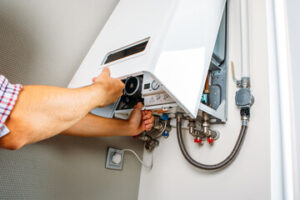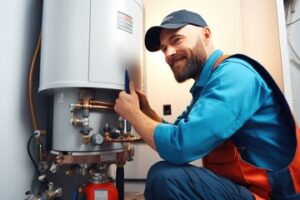When it comes to water heaters, several options are available. These can include conventional storage tanks, also known as tank heaters, and on-demand or tankless models.

Water Heaters Denver CO are environmentally friendly and don’t require gas lines or exhaust flues. They can be positioned closer to the point of use to reduce piping costs and heat losses.
A water heater is one of the biggest consumers of energy in a home. That’s why it makes sense to choose the most energy-efficient water heater for your household. This will save you money on utility bills, reduce greenhouse gas emissions, and improve your home’s environmental impact.
How a water heater uses energy is measured by its energy factor (EF). The higher the EF, the more efficient it is. The EF rating is determined by the water heater’s recovery efficiency, standby heat losses and cycling losses.
High-efficiency electric water heaters use up to 65% less energy than standard electric water heaters. This is because they have lower recovery rates, smaller tanks and more insulation. They also have lower cycling losses. They are a great choice for homes with limited hot water usage and in areas that experience frequent power outages.
Natural gas water heaters require a connection to a gas line and a propane supply. They are a good option for households that want to use clean, low-cost natural gas, but may not be the best choice for homes with children or older adults who may be at risk of a gas leak. In addition, natural gas water heaters produce greenhouse gases, which are produced during the combustion of fossil fuels.
The most efficient conventional gas-fired storage water heaters have ENERGY STAR ratings with an EF of 0.67 to 0.70, corresponding to estimated gas use of 214 to 230 therms per year. Gas-fired tankless water heaters, on the other hand, operate on a different principle and are typically more efficient than traditional storage models. However, there are currently no residential-rated condensing water heaters on the market.
Solar water heaters, which utilize solar panels to capture renewable energy and store it in an insulated tank, are the most environmentally friendly water heater. They can help reduce energy consumption by up to 20%, resulting in lower utility bills and reduced carbon emissions. However, they can be expensive to install and require electrical backup for operation in the event of a power outage. They are also the least cost-effective option for households with high demand for hot water or those with multiple showers being used at the same time.
Safety
Water heaters are a necessity in every home or business, but they come with some hazards that need to be considered. Practicing proper water heater safety can extend their lifespan and keep your family or employees safe in the event of a problem.
Especially if you have an older gas water heater, it’s important to regularly flush it to remove sediment build-up. This sediment can cause the tank to rust internally, increasing the risk of a leak or rupture.
Additionally, old water heaters often have a corrosive environment that can eat away at the steel inside the tank. This can lead to burst tanks, a significant health risk from bacterial growth, and an increased likelihood of scalding.
In addition, it’s important to make sure that there is good ventilation around your water heater. Carbon monoxide can build up in utility closets or other closed spaces where a water heater is located, and this can cause respiratory problems for the people in your home. It’s also a good idea to install carbon monoxide detectors in your home if you have an older gas water heater, as this will warn you of any dangerous leaks of carbon monoxide.
If you have a gas water heater, it’s crucial that nothing combustible is stored within 36 inches of the pilot light. This is because a crack in the water heater can produce gas fumes, and if they come into contact with combustible materials, they can ignite and create an explosion. This is particularly a concern when you store things like coats, jump ropes, and garbage near your gas water heater.
If you ever smell gas, immediately turn off your gas water heater by shutting the valve on the side. You should also leave the house and call the gas company from a neighbor’s phone if possible. Natural gas is colorless and odorless, so the gas company will add a strong scent to it to help you detect a leak. You should also never try to fix a gas leak yourself, as this is a very dangerous situation that requires the expertise of a professional.
Installation
A water heater is a major appliance in any home, delivering hot running water for showering, washing clothes and dishes, cooking, and many other daily chores. But without the proper installation, your hot water may not reach its full potential. A good installation can also improve your home’s energy efficiency and safety. If you want to install a new electric water heater, follow these steps to ensure the safest and best results.
The first step is to disconnect all the incoming water pipes. Drain the old water heater tank, if necessary, and then flush the new line to the drain valve to remove sediment from the pipes. If you’re installing a gas water heater, check your local building codes for requirements on connecting to the gas line. You may need to install a temperature and pressure relief valve, a gas shut-off valve, and a discharge pipe to the outside, depending on your local code.
Obtain and install the right size electrical wiring to match your heater. Most new water heaters use a 240-volt circuit, so you’ll need a new breaker box branching out to the area, or at least a new receptacle. Unless your house has existing natural gas service, a plumber will need to connect the gas line.
If your water heater is on a wooden floor, put down concrete blocks or cinder blocks underneath it to prevent damage from vehicles and other accidents. Water heaters can weigh hundreds of pounds, so it’s important to secure the unit.
Next, attach the cold and hot water supply lines to the heater. If you have copper pipes, solder the open ends to the new copper adapters on top of the water heater. The hot water inlet is on the left side, the cold inlet is on the right. Make sure the venting system is in place, and follow the manufacturer’s instructions for establishing an exhaust pipe that allows combustion fumes to escape safely.
Finally, install a bonding jumper between the hot and cold water pipes serving the water heater, if required by your local building code. This wire helps prevent corrosion in the water piping by transferring electricity from one metal to another, which reduces electrolysis.
Maintenance
Water heaters are a fixture in many homes, but they often go unnoticed. It is easy for homeowners to take these reliable appliances for granted, until a problem arises. Whether it is a faulty thermocouple, a leaking tank or a broken thermostat, minor problems can escalate into a disaster, leaving you with a flooded utility closet and a costly repair bill.
Regular maintenance and inspections can prevent these issues from developing in the first place. For example, a simple task like draining your water heater can help extend the lifespan of your appliance and save on energy costs. To do this, shut off the power and water to your unit. Open a hot water faucet in the house, which will relieve pressure and allow water to flow out of the tank. Draining two or three gallons of water will flush out sediments that reduce your energy efficiency.
Another important maintenance item is a visual check of your unit for signs of leaks and corrosion. A rusty tank may be in need of replacement, and even a small leak can lead to a flooded basement.
You should also drain and flush your tank on a regular basis. This will help to avoid sediment build-up, which reduces your unit’s efficiency and shortens its operating life. Draining is as simple as opening a drain valve, and you should wait until the water runs clear to stop the flow.
It is also a good idea to flush your heating elements on a regular basis. These are located on the top of the tank and look similar to a light bulb. They are usually covered with a plastic cover, which you should remove using a screwdriver. Then you can use an ohm meter to test the electrical continuity of each element. If one is defective, you can replace it with a new one from a hardware store.
If your unit is over 10 years old, it is probably time to consider a replacement. A professional can help you select a model that is cost effective in terms of annual operating costs and installation.
